Winter 2020 Business Plan: Tim Hortons in India (IBUS4540)
VerifiedAdded on 2022/09/13
|15
|2857
|13
Report
AI Summary
This report provides a comprehensive business plan for Tim Hortons' proposed expansion into the Indian market. It begins with an executive summary outlining the key aspects of the plan, followed by an introduction that sets the context for the analysis. The core of the report involves a CAGE analysis (Cultural, Administrative, Geographic, and Economic) to assess the international business opportunity in India. This is followed by a detailed discussion of the proposed business operations, including the organization's structure, the selected food and beverage offerings, and the market entry strategy. The report also includes a thorough marketing strategy plan designed to ensure Tim Hortons' successful entry into the lucrative Indian market. The plan focuses on intensive growth strategies, market penetration, and development. The report concludes with references and an appendix, providing additional supporting information. The business plan addresses various factors like cultural differences, geographic attributes, and economic conditions to determine the feasibility of the business venture in the Indian market.
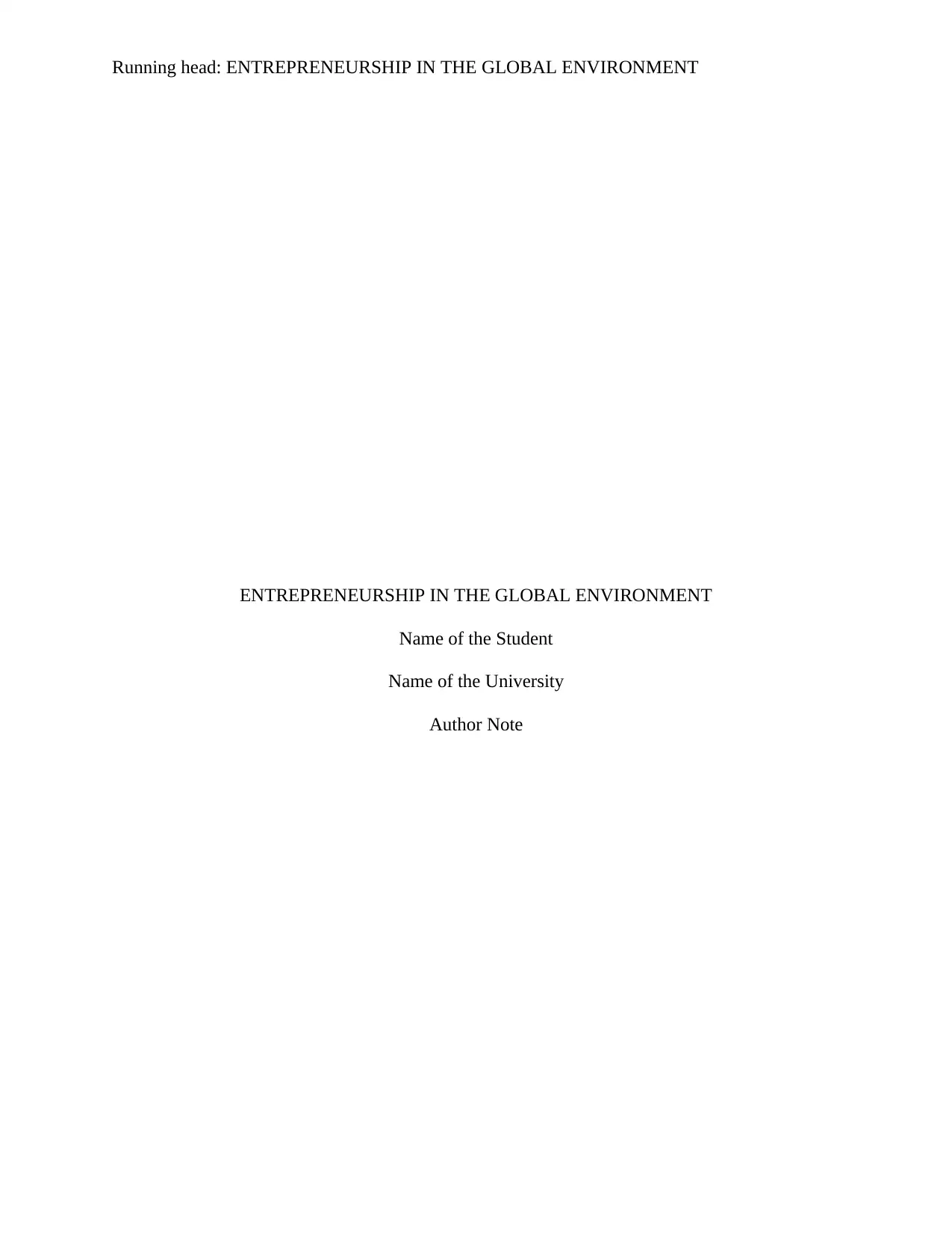
Running head: ENTREPRENEURSHIP IN THE GLOBAL ENVIRONMENT
ENTREPRENEURSHIP IN THE GLOBAL ENVIRONMENT
Name of the Student
Name of the University
Author Note
ENTREPRENEURSHIP IN THE GLOBAL ENVIRONMENT
Name of the Student
Name of the University
Author Note
Paraphrase This Document
Need a fresh take? Get an instant paraphrase of this document with our AI Paraphraser
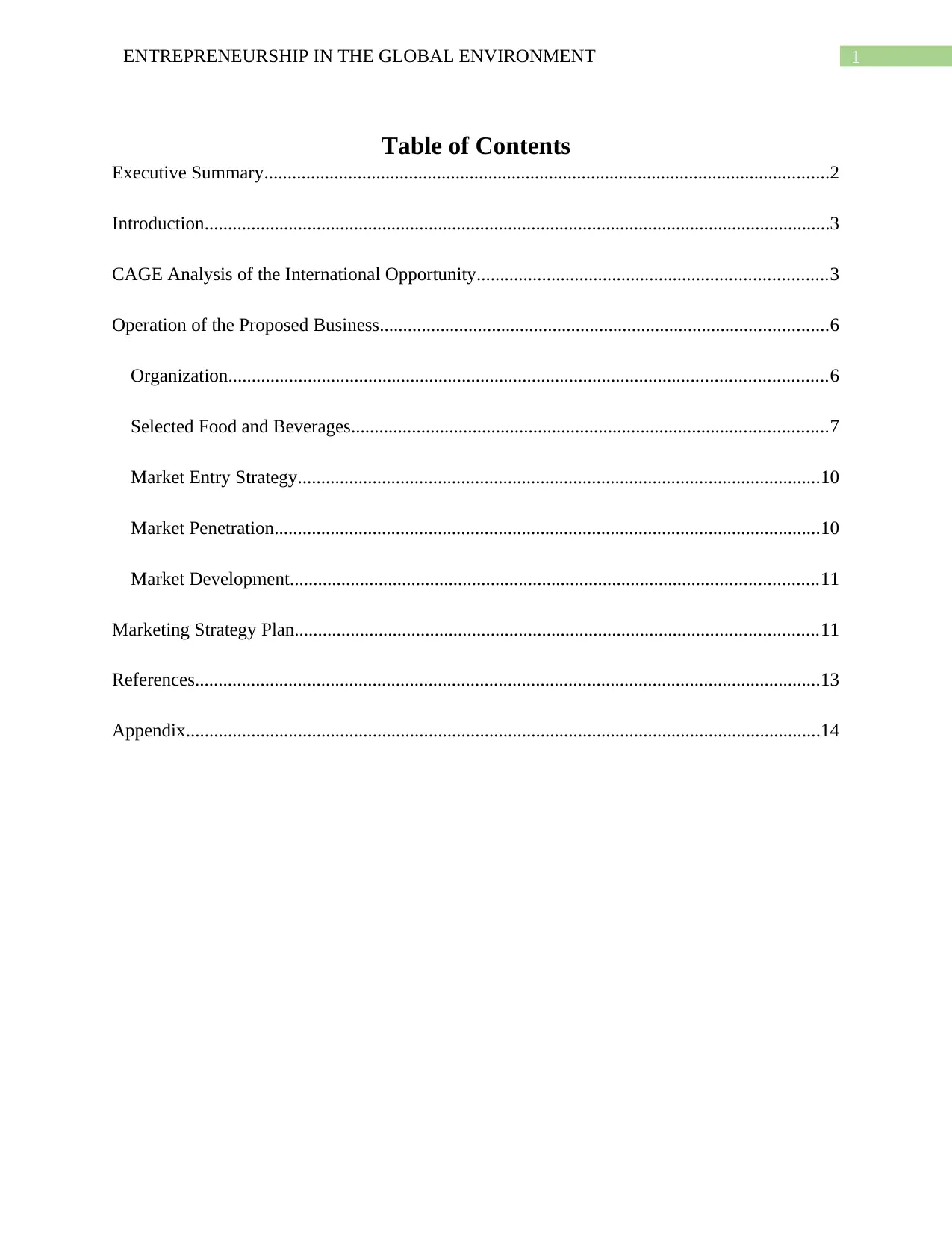
1ENTREPRENEURSHIP IN THE GLOBAL ENVIRONMENT
Table of Contents
Executive Summary.........................................................................................................................2
Introduction......................................................................................................................................3
CAGE Analysis of the International Opportunity...........................................................................3
Operation of the Proposed Business................................................................................................6
Organization................................................................................................................................6
Selected Food and Beverages......................................................................................................7
Market Entry Strategy................................................................................................................10
Market Penetration.....................................................................................................................10
Market Development.................................................................................................................11
Marketing Strategy Plan................................................................................................................11
References......................................................................................................................................13
Appendix........................................................................................................................................14
Table of Contents
Executive Summary.........................................................................................................................2
Introduction......................................................................................................................................3
CAGE Analysis of the International Opportunity...........................................................................3
Operation of the Proposed Business................................................................................................6
Organization................................................................................................................................6
Selected Food and Beverages......................................................................................................7
Market Entry Strategy................................................................................................................10
Market Penetration.....................................................................................................................10
Market Development.................................................................................................................11
Marketing Strategy Plan................................................................................................................11
References......................................................................................................................................13
Appendix........................................................................................................................................14
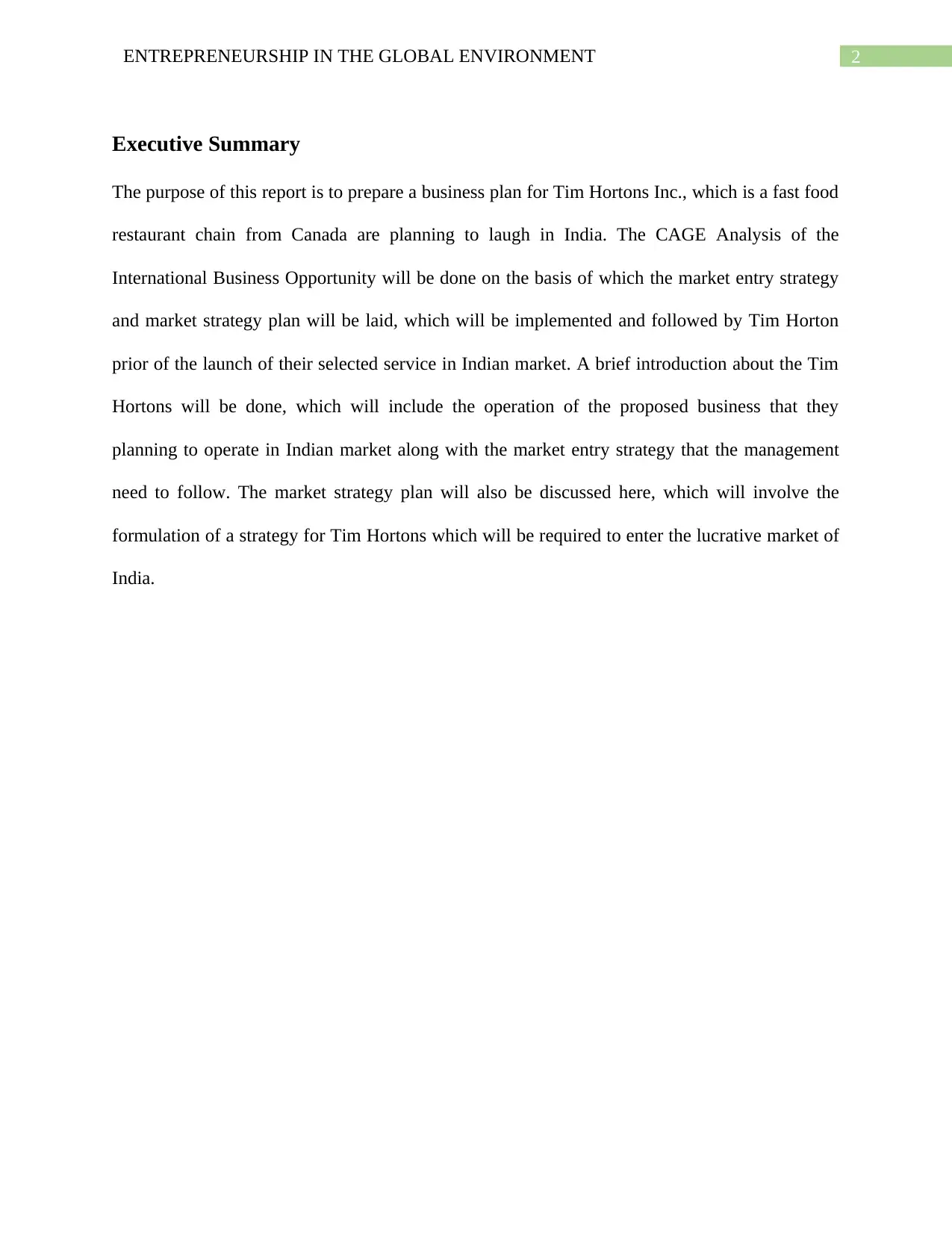
2ENTREPRENEURSHIP IN THE GLOBAL ENVIRONMENT
Executive Summary
The purpose of this report is to prepare a business plan for Tim Hortons Inc., which is a fast food
restaurant chain from Canada are planning to laugh in India. The CAGE Analysis of the
International Business Opportunity will be done on the basis of which the market entry strategy
and market strategy plan will be laid, which will be implemented and followed by Tim Horton
prior of the launch of their selected service in Indian market. A brief introduction about the Tim
Hortons will be done, which will include the operation of the proposed business that they
planning to operate in Indian market along with the market entry strategy that the management
need to follow. The market strategy plan will also be discussed here, which will involve the
formulation of a strategy for Tim Hortons which will be required to enter the lucrative market of
India.
Executive Summary
The purpose of this report is to prepare a business plan for Tim Hortons Inc., which is a fast food
restaurant chain from Canada are planning to laugh in India. The CAGE Analysis of the
International Business Opportunity will be done on the basis of which the market entry strategy
and market strategy plan will be laid, which will be implemented and followed by Tim Horton
prior of the launch of their selected service in Indian market. A brief introduction about the Tim
Hortons will be done, which will include the operation of the proposed business that they
planning to operate in Indian market along with the market entry strategy that the management
need to follow. The market strategy plan will also be discussed here, which will involve the
formulation of a strategy for Tim Hortons which will be required to enter the lucrative market of
India.
⊘ This is a preview!⊘
Do you want full access?
Subscribe today to unlock all pages.

Trusted by 1+ million students worldwide
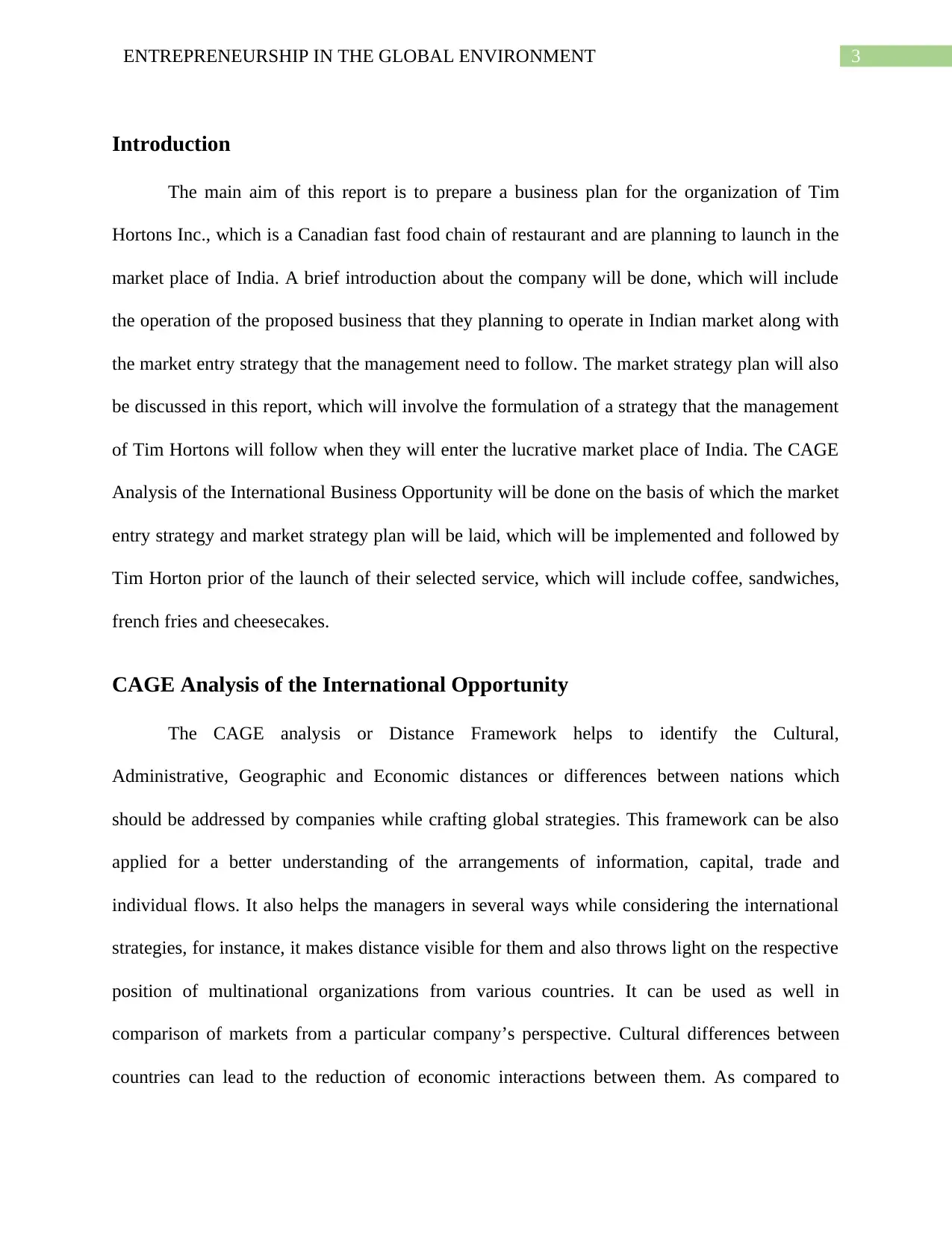
3ENTREPRENEURSHIP IN THE GLOBAL ENVIRONMENT
Introduction
The main aim of this report is to prepare a business plan for the organization of Tim
Hortons Inc., which is a Canadian fast food chain of restaurant and are planning to launch in the
market place of India. A brief introduction about the company will be done, which will include
the operation of the proposed business that they planning to operate in Indian market along with
the market entry strategy that the management need to follow. The market strategy plan will also
be discussed in this report, which will involve the formulation of a strategy that the management
of Tim Hortons will follow when they will enter the lucrative market place of India. The CAGE
Analysis of the International Business Opportunity will be done on the basis of which the market
entry strategy and market strategy plan will be laid, which will be implemented and followed by
Tim Horton prior of the launch of their selected service, which will include coffee, sandwiches,
french fries and cheesecakes.
CAGE Analysis of the International Opportunity
The CAGE analysis or Distance Framework helps to identify the Cultural,
Administrative, Geographic and Economic distances or differences between nations which
should be addressed by companies while crafting global strategies. This framework can be also
applied for a better understanding of the arrangements of information, capital, trade and
individual flows. It also helps the managers in several ways while considering the international
strategies, for instance, it makes distance visible for them and also throws light on the respective
position of multinational organizations from various countries. It can be used as well in
comparison of markets from a particular company’s perspective. Cultural differences between
countries can lead to the reduction of economic interactions between them. As compared to
Introduction
The main aim of this report is to prepare a business plan for the organization of Tim
Hortons Inc., which is a Canadian fast food chain of restaurant and are planning to launch in the
market place of India. A brief introduction about the company will be done, which will include
the operation of the proposed business that they planning to operate in Indian market along with
the market entry strategy that the management need to follow. The market strategy plan will also
be discussed in this report, which will involve the formulation of a strategy that the management
of Tim Hortons will follow when they will enter the lucrative market place of India. The CAGE
Analysis of the International Business Opportunity will be done on the basis of which the market
entry strategy and market strategy plan will be laid, which will be implemented and followed by
Tim Horton prior of the launch of their selected service, which will include coffee, sandwiches,
french fries and cheesecakes.
CAGE Analysis of the International Opportunity
The CAGE analysis or Distance Framework helps to identify the Cultural,
Administrative, Geographic and Economic distances or differences between nations which
should be addressed by companies while crafting global strategies. This framework can be also
applied for a better understanding of the arrangements of information, capital, trade and
individual flows. It also helps the managers in several ways while considering the international
strategies, for instance, it makes distance visible for them and also throws light on the respective
position of multinational organizations from various countries. It can be used as well in
comparison of markets from a particular company’s perspective. Cultural differences between
countries can lead to the reduction of economic interactions between them. As compared to
Paraphrase This Document
Need a fresh take? Get an instant paraphrase of this document with our AI Paraphraser
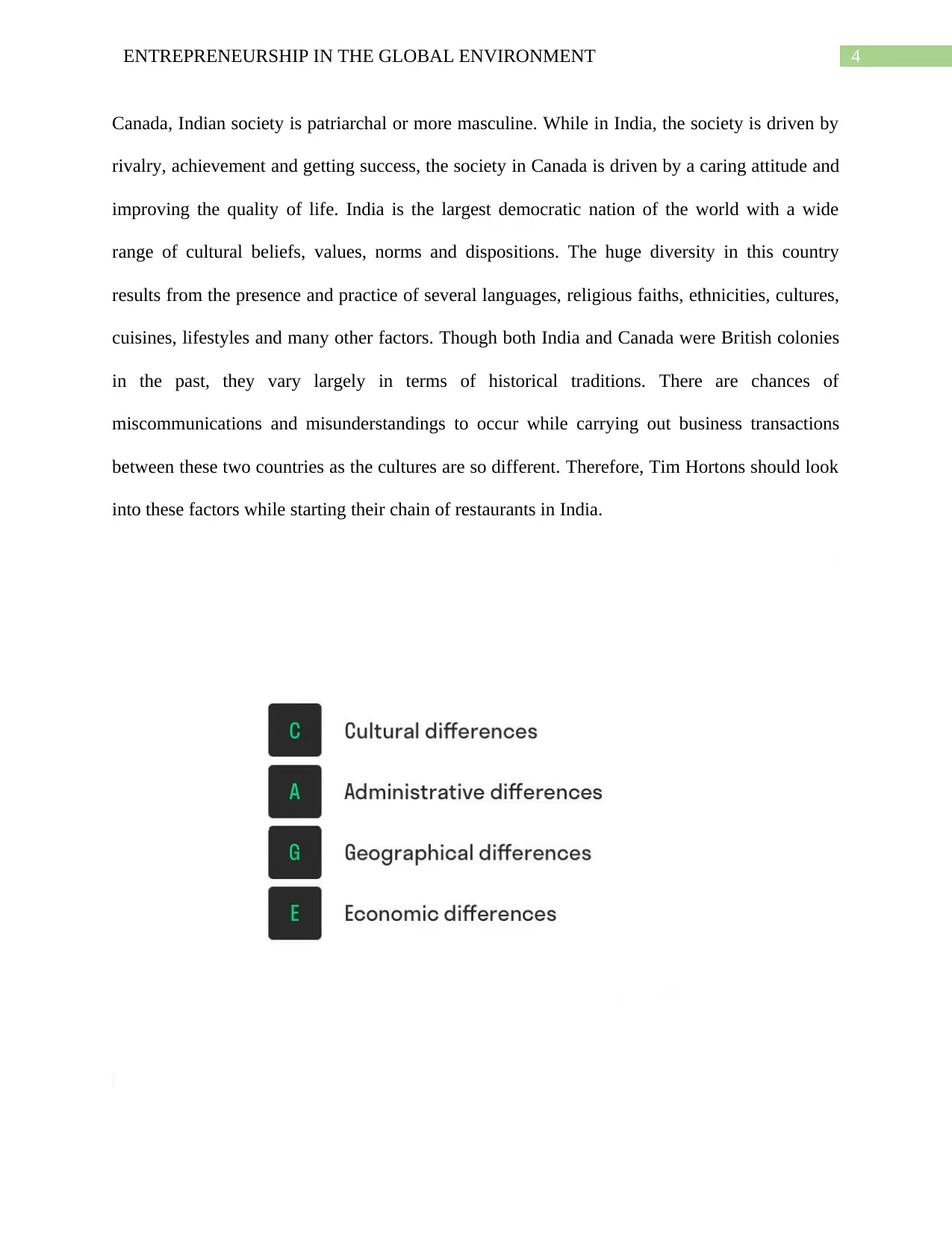
4ENTREPRENEURSHIP IN THE GLOBAL ENVIRONMENT
Canada, Indian society is patriarchal or more masculine. While in India, the society is driven by
rivalry, achievement and getting success, the society in Canada is driven by a caring attitude and
improving the quality of life. India is the largest democratic nation of the world with a wide
range of cultural beliefs, values, norms and dispositions. The huge diversity in this country
results from the presence and practice of several languages, religious faiths, ethnicities, cultures,
cuisines, lifestyles and many other factors. Though both India and Canada were British colonies
in the past, they vary largely in terms of historical traditions. There are chances of
miscommunications and misunderstandings to occur while carrying out business transactions
between these two countries as the cultures are so different. Therefore, Tim Hortons should look
into these factors while starting their chain of restaurants in India.
Canada, Indian society is patriarchal or more masculine. While in India, the society is driven by
rivalry, achievement and getting success, the society in Canada is driven by a caring attitude and
improving the quality of life. India is the largest democratic nation of the world with a wide
range of cultural beliefs, values, norms and dispositions. The huge diversity in this country
results from the presence and practice of several languages, religious faiths, ethnicities, cultures,
cuisines, lifestyles and many other factors. Though both India and Canada were British colonies
in the past, they vary largely in terms of historical traditions. There are chances of
miscommunications and misunderstandings to occur while carrying out business transactions
between these two countries as the cultures are so different. Therefore, Tim Hortons should look
into these factors while starting their chain of restaurants in India.
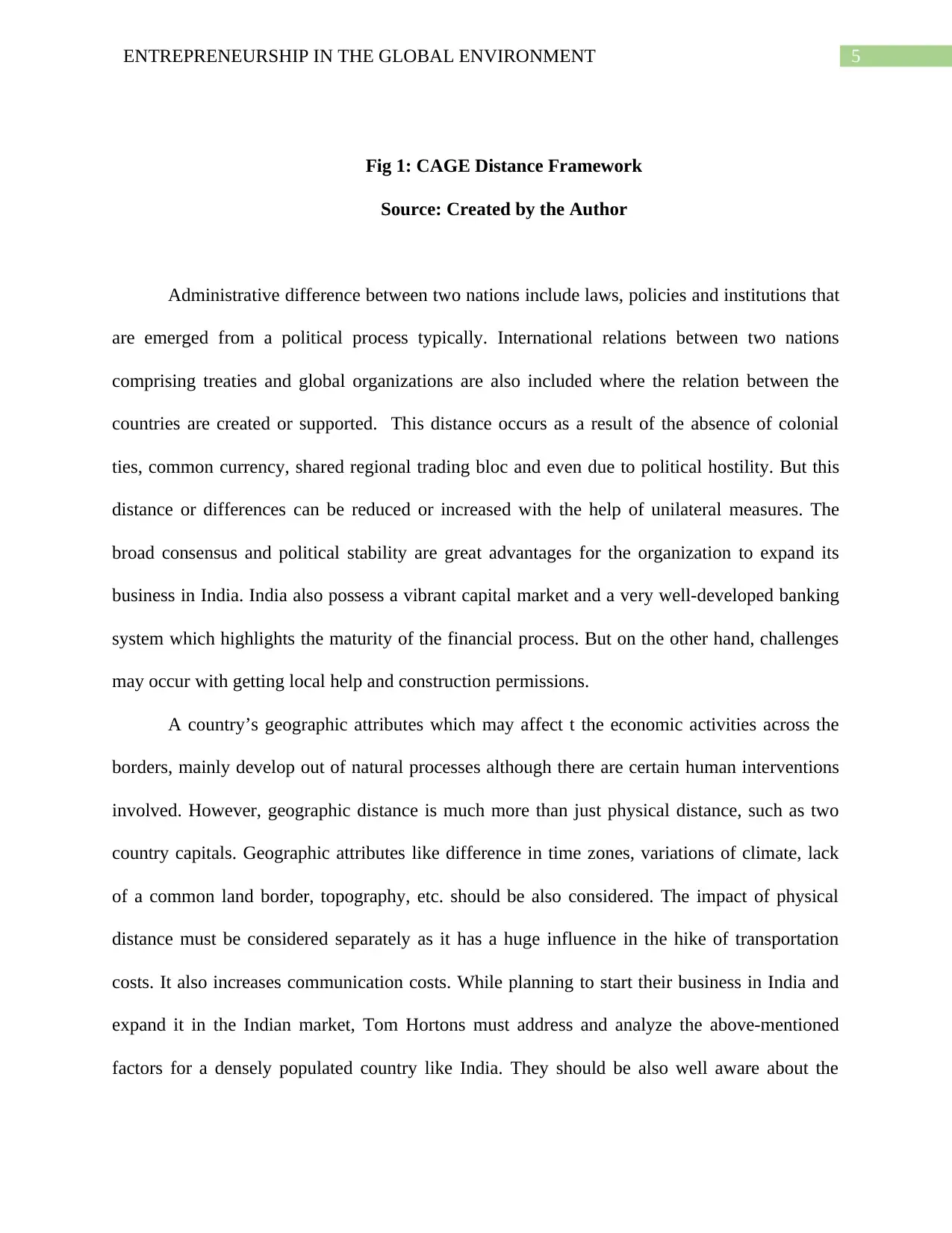
5ENTREPRENEURSHIP IN THE GLOBAL ENVIRONMENT
Fig 1: CAGE Distance Framework
Source: Created by the Author
Administrative difference between two nations include laws, policies and institutions that
are emerged from a political process typically. International relations between two nations
comprising treaties and global organizations are also included where the relation between the
countries are created or supported. This distance occurs as a result of the absence of colonial
ties, common currency, shared regional trading bloc and even due to political hostility. But this
distance or differences can be reduced or increased with the help of unilateral measures. The
broad consensus and political stability are great advantages for the organization to expand its
business in India. India also possess a vibrant capital market and a very well-developed banking
system which highlights the maturity of the financial process. But on the other hand, challenges
may occur with getting local help and construction permissions.
A country’s geographic attributes which may affect t the economic activities across the
borders, mainly develop out of natural processes although there are certain human interventions
involved. However, geographic distance is much more than just physical distance, such as two
country capitals. Geographic attributes like difference in time zones, variations of climate, lack
of a common land border, topography, etc. should be also considered. The impact of physical
distance must be considered separately as it has a huge influence in the hike of transportation
costs. It also increases communication costs. While planning to start their business in India and
expand it in the Indian market, Tom Hortons must address and analyze the above-mentioned
factors for a densely populated country like India. They should be also well aware about the
Fig 1: CAGE Distance Framework
Source: Created by the Author
Administrative difference between two nations include laws, policies and institutions that
are emerged from a political process typically. International relations between two nations
comprising treaties and global organizations are also included where the relation between the
countries are created or supported. This distance occurs as a result of the absence of colonial
ties, common currency, shared regional trading bloc and even due to political hostility. But this
distance or differences can be reduced or increased with the help of unilateral measures. The
broad consensus and political stability are great advantages for the organization to expand its
business in India. India also possess a vibrant capital market and a very well-developed banking
system which highlights the maturity of the financial process. But on the other hand, challenges
may occur with getting local help and construction permissions.
A country’s geographic attributes which may affect t the economic activities across the
borders, mainly develop out of natural processes although there are certain human interventions
involved. However, geographic distance is much more than just physical distance, such as two
country capitals. Geographic attributes like difference in time zones, variations of climate, lack
of a common land border, topography, etc. should be also considered. The impact of physical
distance must be considered separately as it has a huge influence in the hike of transportation
costs. It also increases communication costs. While planning to start their business in India and
expand it in the Indian market, Tom Hortons must address and analyze the above-mentioned
factors for a densely populated country like India. They should be also well aware about the
⊘ This is a preview!⊘
Do you want full access?
Subscribe today to unlock all pages.

Trusted by 1+ million students worldwide
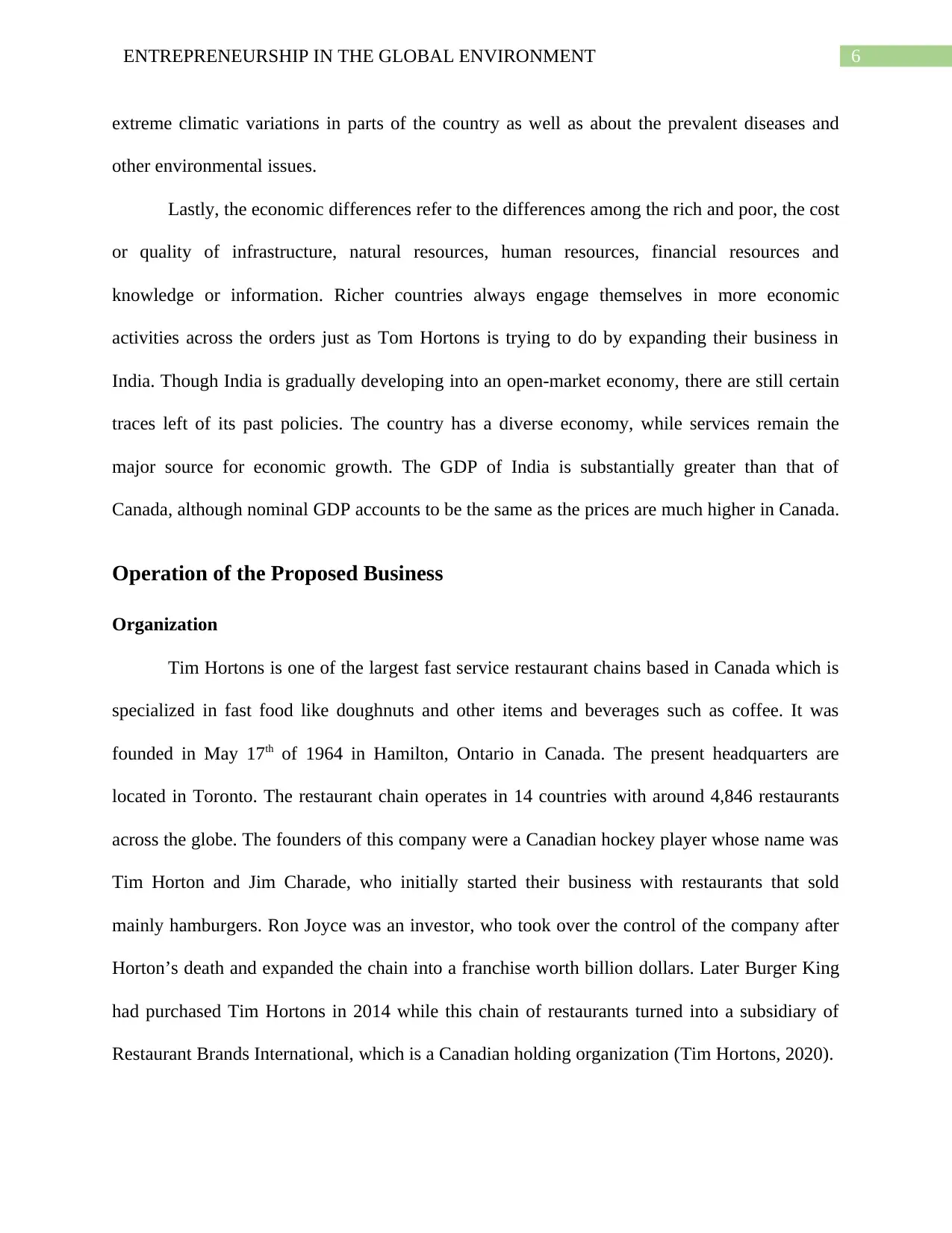
6ENTREPRENEURSHIP IN THE GLOBAL ENVIRONMENT
extreme climatic variations in parts of the country as well as about the prevalent diseases and
other environmental issues.
Lastly, the economic differences refer to the differences among the rich and poor, the cost
or quality of infrastructure, natural resources, human resources, financial resources and
knowledge or information. Richer countries always engage themselves in more economic
activities across the orders just as Tom Hortons is trying to do by expanding their business in
India. Though India is gradually developing into an open-market economy, there are still certain
traces left of its past policies. The country has a diverse economy, while services remain the
major source for economic growth. The GDP of India is substantially greater than that of
Canada, although nominal GDP accounts to be the same as the prices are much higher in Canada.
Operation of the Proposed Business
Organization
Tim Hortons is one of the largest fast service restaurant chains based in Canada which is
specialized in fast food like doughnuts and other items and beverages such as coffee. It was
founded in May 17th of 1964 in Hamilton, Ontario in Canada. The present headquarters are
located in Toronto. The restaurant chain operates in 14 countries with around 4,846 restaurants
across the globe. The founders of this company were a Canadian hockey player whose name was
Tim Horton and Jim Charade, who initially started their business with restaurants that sold
mainly hamburgers. Ron Joyce was an investor, who took over the control of the company after
Horton’s death and expanded the chain into a franchise worth billion dollars. Later Burger King
had purchased Tim Hortons in 2014 while this chain of restaurants turned into a subsidiary of
Restaurant Brands International, which is a Canadian holding organization (Tim Hortons, 2020).
extreme climatic variations in parts of the country as well as about the prevalent diseases and
other environmental issues.
Lastly, the economic differences refer to the differences among the rich and poor, the cost
or quality of infrastructure, natural resources, human resources, financial resources and
knowledge or information. Richer countries always engage themselves in more economic
activities across the orders just as Tom Hortons is trying to do by expanding their business in
India. Though India is gradually developing into an open-market economy, there are still certain
traces left of its past policies. The country has a diverse economy, while services remain the
major source for economic growth. The GDP of India is substantially greater than that of
Canada, although nominal GDP accounts to be the same as the prices are much higher in Canada.
Operation of the Proposed Business
Organization
Tim Hortons is one of the largest fast service restaurant chains based in Canada which is
specialized in fast food like doughnuts and other items and beverages such as coffee. It was
founded in May 17th of 1964 in Hamilton, Ontario in Canada. The present headquarters are
located in Toronto. The restaurant chain operates in 14 countries with around 4,846 restaurants
across the globe. The founders of this company were a Canadian hockey player whose name was
Tim Horton and Jim Charade, who initially started their business with restaurants that sold
mainly hamburgers. Ron Joyce was an investor, who took over the control of the company after
Horton’s death and expanded the chain into a franchise worth billion dollars. Later Burger King
had purchased Tim Hortons in 2014 while this chain of restaurants turned into a subsidiary of
Restaurant Brands International, which is a Canadian holding organization (Tim Hortons, 2020).
Paraphrase This Document
Need a fresh take? Get an instant paraphrase of this document with our AI Paraphraser
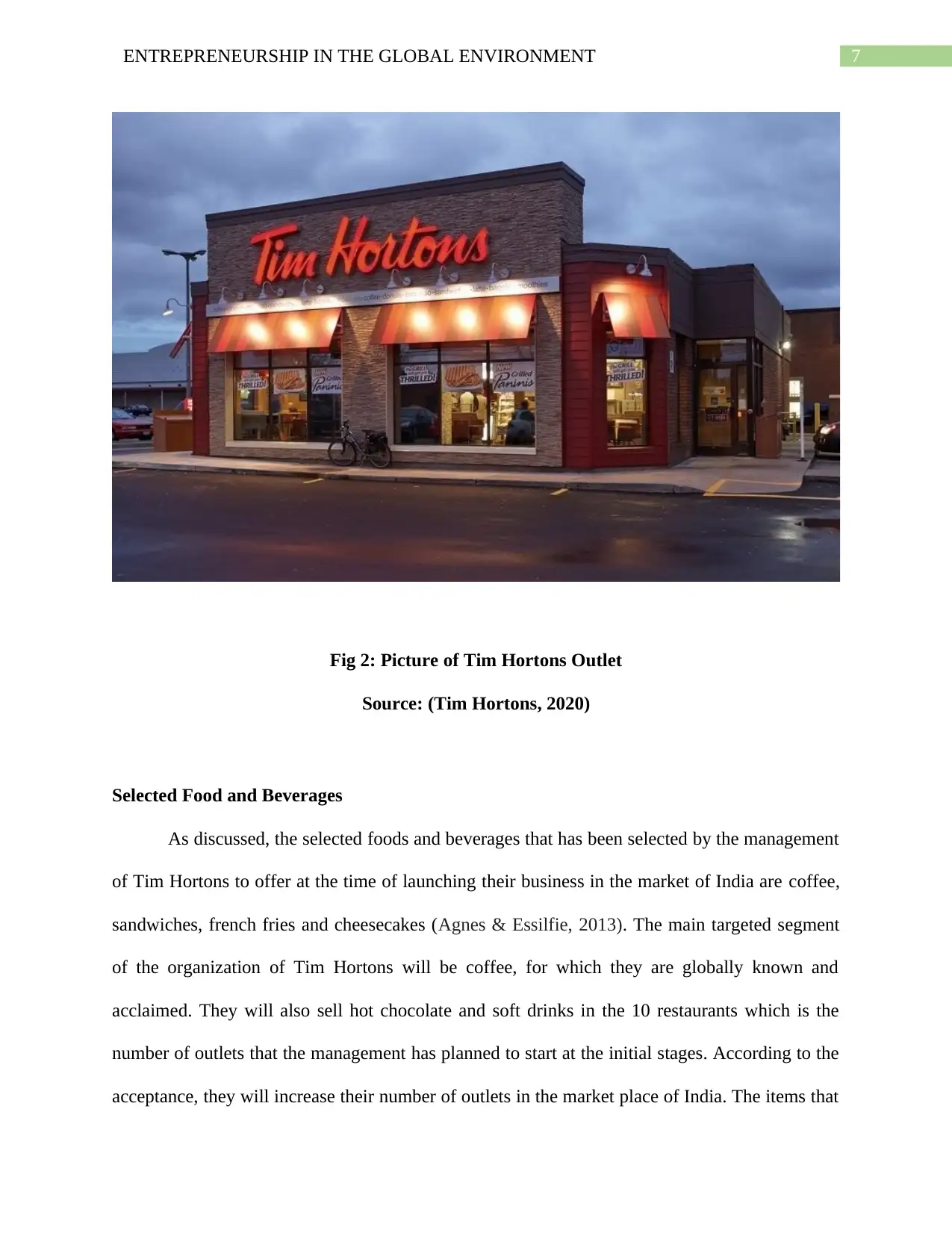
7ENTREPRENEURSHIP IN THE GLOBAL ENVIRONMENT
Fig 2: Picture of Tim Hortons Outlet
Source: (Tim Hortons, 2020)
Selected Food and Beverages
As discussed, the selected foods and beverages that has been selected by the management
of Tim Hortons to offer at the time of launching their business in the market of India are coffee,
sandwiches, french fries and cheesecakes (Agnes & Essilfie, 2013). The main targeted segment
of the organization of Tim Hortons will be coffee, for which they are globally known and
acclaimed. They will also sell hot chocolate and soft drinks in the 10 restaurants which is the
number of outlets that the management has planned to start at the initial stages. According to the
acceptance, they will increase their number of outlets in the market place of India. The items that
Fig 2: Picture of Tim Hortons Outlet
Source: (Tim Hortons, 2020)
Selected Food and Beverages
As discussed, the selected foods and beverages that has been selected by the management
of Tim Hortons to offer at the time of launching their business in the market of India are coffee,
sandwiches, french fries and cheesecakes (Agnes & Essilfie, 2013). The main targeted segment
of the organization of Tim Hortons will be coffee, for which they are globally known and
acclaimed. They will also sell hot chocolate and soft drinks in the 10 restaurants which is the
number of outlets that the management has planned to start at the initial stages. According to the
acceptance, they will increase their number of outlets in the market place of India. The items that
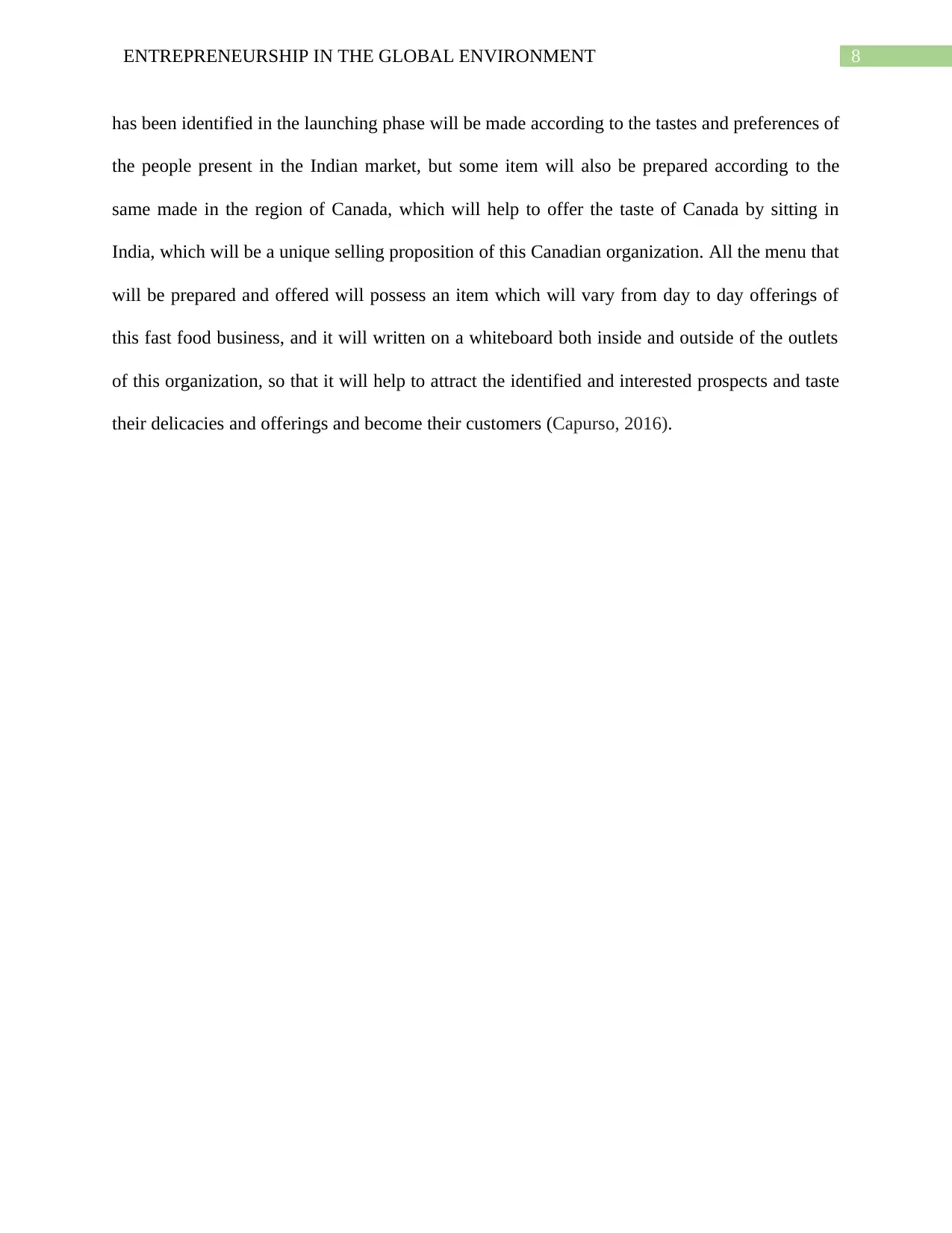
8ENTREPRENEURSHIP IN THE GLOBAL ENVIRONMENT
has been identified in the launching phase will be made according to the tastes and preferences of
the people present in the Indian market, but some item will also be prepared according to the
same made in the region of Canada, which will help to offer the taste of Canada by sitting in
India, which will be a unique selling proposition of this Canadian organization. All the menu that
will be prepared and offered will possess an item which will vary from day to day offerings of
this fast food business, and it will written on a whiteboard both inside and outside of the outlets
of this organization, so that it will help to attract the identified and interested prospects and taste
their delicacies and offerings and become their customers (Capurso, 2016).
has been identified in the launching phase will be made according to the tastes and preferences of
the people present in the Indian market, but some item will also be prepared according to the
same made in the region of Canada, which will help to offer the taste of Canada by sitting in
India, which will be a unique selling proposition of this Canadian organization. All the menu that
will be prepared and offered will possess an item which will vary from day to day offerings of
this fast food business, and it will written on a whiteboard both inside and outside of the outlets
of this organization, so that it will help to attract the identified and interested prospects and taste
their delicacies and offerings and become their customers (Capurso, 2016).
⊘ This is a preview!⊘
Do you want full access?
Subscribe today to unlock all pages.

Trusted by 1+ million students worldwide
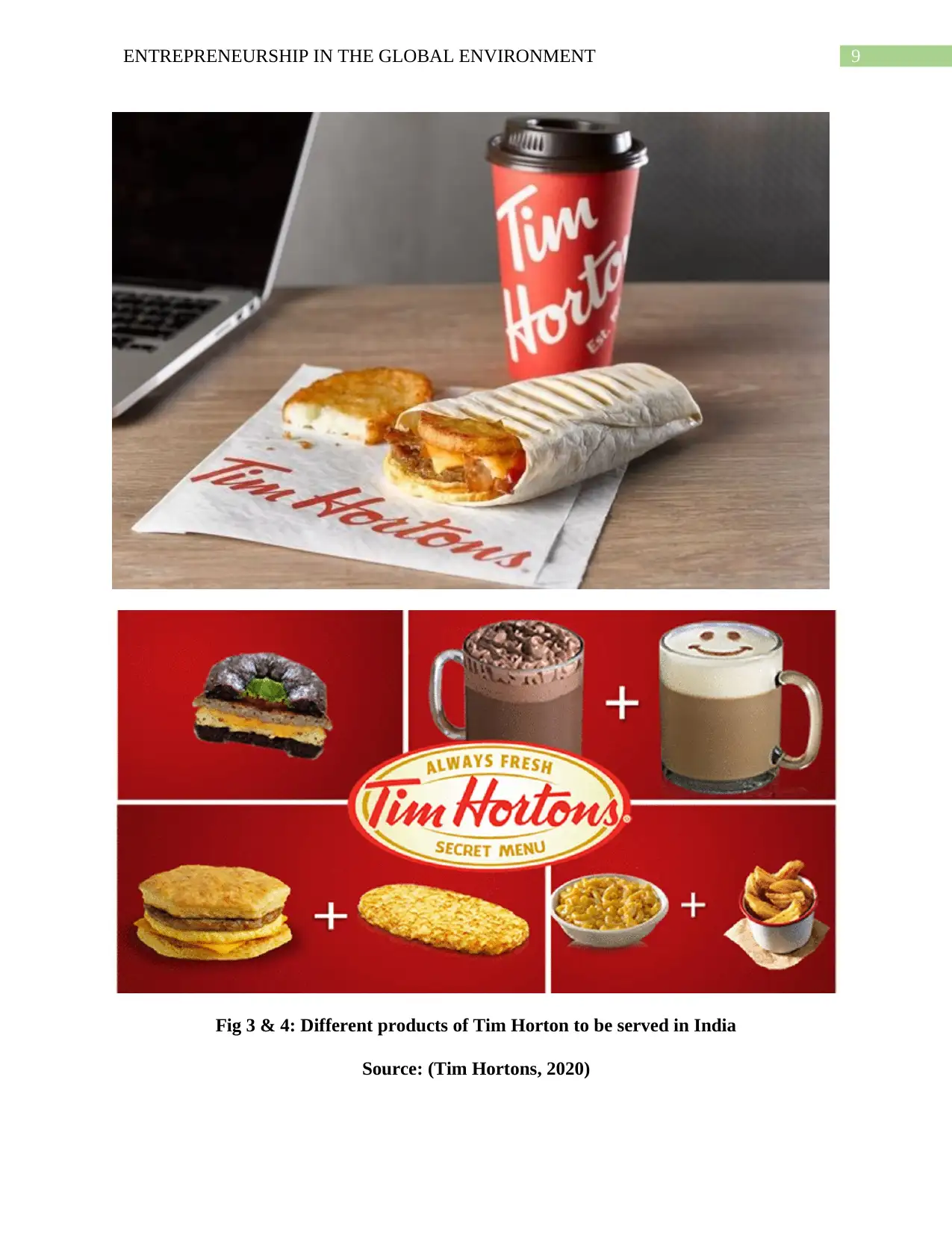
9ENTREPRENEURSHIP IN THE GLOBAL ENVIRONMENT
Fig 3 & 4: Different products of Tim Horton to be served in India
Source: (Tim Hortons, 2020)
Fig 3 & 4: Different products of Tim Horton to be served in India
Source: (Tim Hortons, 2020)
Paraphrase This Document
Need a fresh take? Get an instant paraphrase of this document with our AI Paraphraser
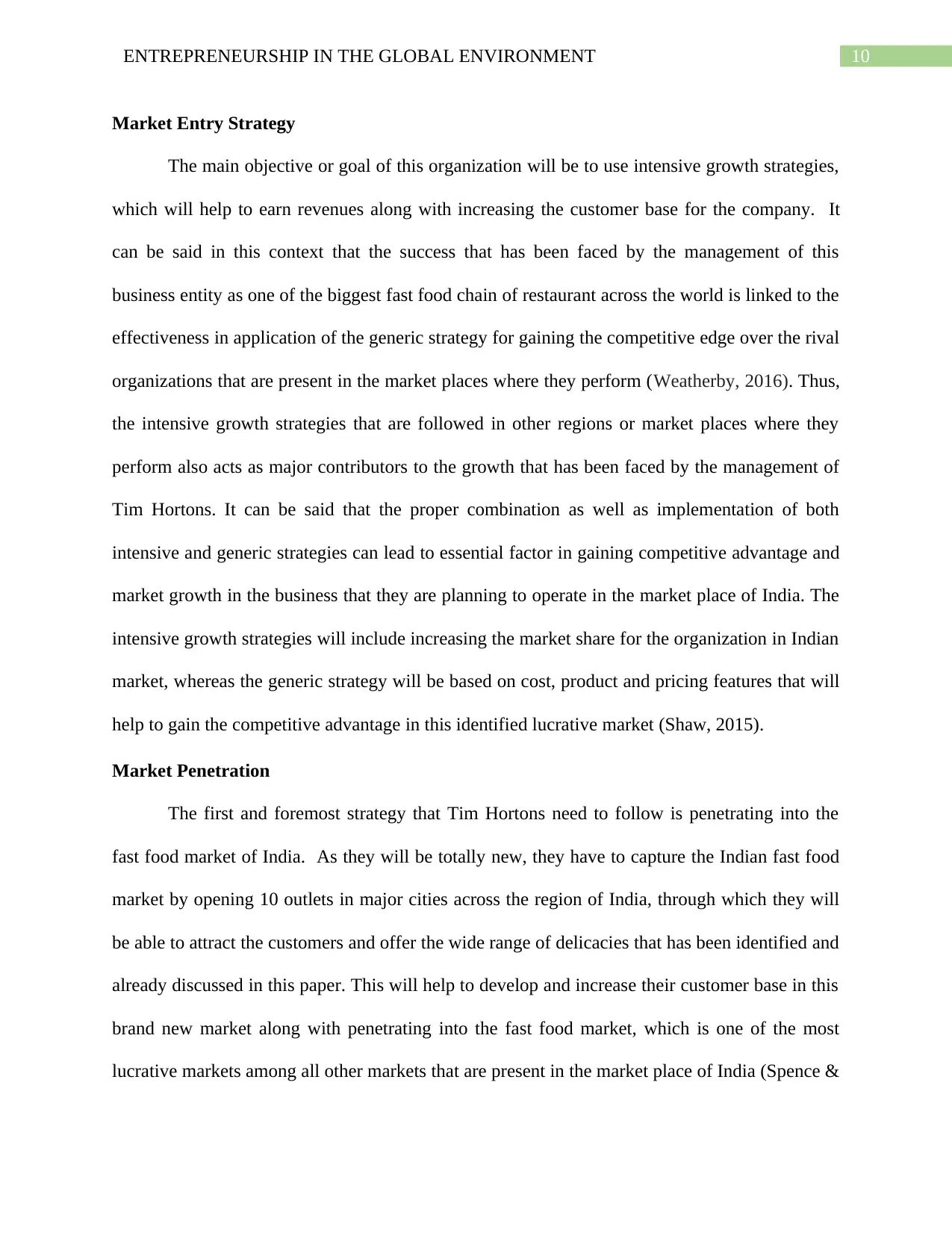
10ENTREPRENEURSHIP IN THE GLOBAL ENVIRONMENT
Market Entry Strategy
The main objective or goal of this organization will be to use intensive growth strategies,
which will help to earn revenues along with increasing the customer base for the company. It
can be said in this context that the success that has been faced by the management of this
business entity as one of the biggest fast food chain of restaurant across the world is linked to the
effectiveness in application of the generic strategy for gaining the competitive edge over the rival
organizations that are present in the market places where they perform (Weatherby, 2016). Thus,
the intensive growth strategies that are followed in other regions or market places where they
perform also acts as major contributors to the growth that has been faced by the management of
Tim Hortons. It can be said that the proper combination as well as implementation of both
intensive and generic strategies can lead to essential factor in gaining competitive advantage and
market growth in the business that they are planning to operate in the market place of India. The
intensive growth strategies will include increasing the market share for the organization in Indian
market, whereas the generic strategy will be based on cost, product and pricing features that will
help to gain the competitive advantage in this identified lucrative market (Shaw, 2015).
Market Penetration
The first and foremost strategy that Tim Hortons need to follow is penetrating into the
fast food market of India. As they will be totally new, they have to capture the Indian fast food
market by opening 10 outlets in major cities across the region of India, through which they will
be able to attract the customers and offer the wide range of delicacies that has been identified and
already discussed in this paper. This will help to develop and increase their customer base in this
brand new market along with penetrating into the fast food market, which is one of the most
lucrative markets among all other markets that are present in the market place of India (Spence &
Market Entry Strategy
The main objective or goal of this organization will be to use intensive growth strategies,
which will help to earn revenues along with increasing the customer base for the company. It
can be said in this context that the success that has been faced by the management of this
business entity as one of the biggest fast food chain of restaurant across the world is linked to the
effectiveness in application of the generic strategy for gaining the competitive edge over the rival
organizations that are present in the market places where they perform (Weatherby, 2016). Thus,
the intensive growth strategies that are followed in other regions or market places where they
perform also acts as major contributors to the growth that has been faced by the management of
Tim Hortons. It can be said that the proper combination as well as implementation of both
intensive and generic strategies can lead to essential factor in gaining competitive advantage and
market growth in the business that they are planning to operate in the market place of India. The
intensive growth strategies will include increasing the market share for the organization in Indian
market, whereas the generic strategy will be based on cost, product and pricing features that will
help to gain the competitive advantage in this identified lucrative market (Shaw, 2015).
Market Penetration
The first and foremost strategy that Tim Hortons need to follow is penetrating into the
fast food market of India. As they will be totally new, they have to capture the Indian fast food
market by opening 10 outlets in major cities across the region of India, through which they will
be able to attract the customers and offer the wide range of delicacies that has been identified and
already discussed in this paper. This will help to develop and increase their customer base in this
brand new market along with penetrating into the fast food market, which is one of the most
lucrative markets among all other markets that are present in the market place of India (Spence &
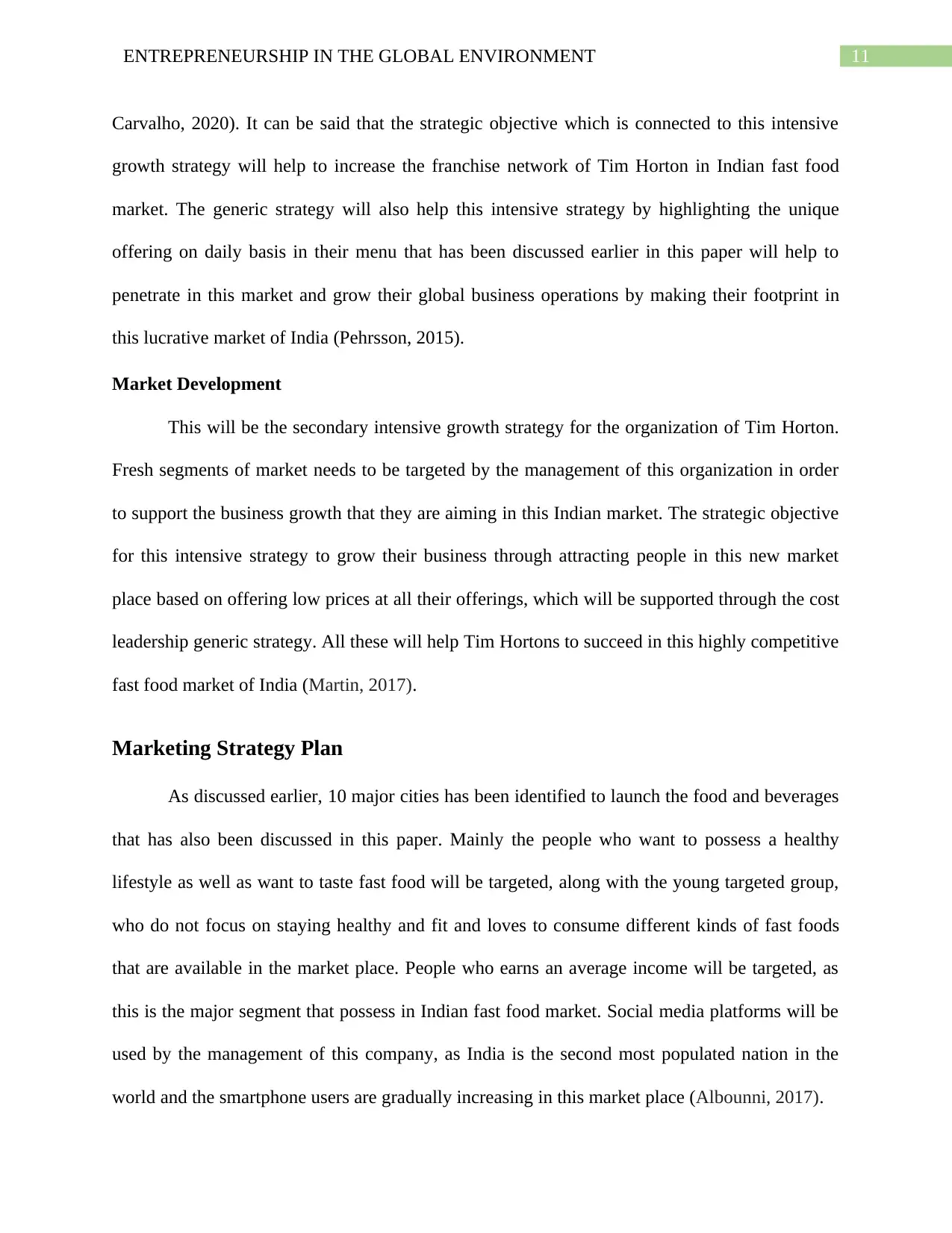
11ENTREPRENEURSHIP IN THE GLOBAL ENVIRONMENT
Carvalho, 2020). It can be said that the strategic objective which is connected to this intensive
growth strategy will help to increase the franchise network of Tim Horton in Indian fast food
market. The generic strategy will also help this intensive strategy by highlighting the unique
offering on daily basis in their menu that has been discussed earlier in this paper will help to
penetrate in this market and grow their global business operations by making their footprint in
this lucrative market of India (Pehrsson, 2015).
Market Development
This will be the secondary intensive growth strategy for the organization of Tim Horton.
Fresh segments of market needs to be targeted by the management of this organization in order
to support the business growth that they are aiming in this Indian market. The strategic objective
for this intensive strategy to grow their business through attracting people in this new market
place based on offering low prices at all their offerings, which will be supported through the cost
leadership generic strategy. All these will help Tim Hortons to succeed in this highly competitive
fast food market of India (Martin, 2017).
Marketing Strategy Plan
As discussed earlier, 10 major cities has been identified to launch the food and beverages
that has also been discussed in this paper. Mainly the people who want to possess a healthy
lifestyle as well as want to taste fast food will be targeted, along with the young targeted group,
who do not focus on staying healthy and fit and loves to consume different kinds of fast foods
that are available in the market place. People who earns an average income will be targeted, as
this is the major segment that possess in Indian fast food market. Social media platforms will be
used by the management of this company, as India is the second most populated nation in the
world and the smartphone users are gradually increasing in this market place (Albounni, 2017).
Carvalho, 2020). It can be said that the strategic objective which is connected to this intensive
growth strategy will help to increase the franchise network of Tim Horton in Indian fast food
market. The generic strategy will also help this intensive strategy by highlighting the unique
offering on daily basis in their menu that has been discussed earlier in this paper will help to
penetrate in this market and grow their global business operations by making their footprint in
this lucrative market of India (Pehrsson, 2015).
Market Development
This will be the secondary intensive growth strategy for the organization of Tim Horton.
Fresh segments of market needs to be targeted by the management of this organization in order
to support the business growth that they are aiming in this Indian market. The strategic objective
for this intensive strategy to grow their business through attracting people in this new market
place based on offering low prices at all their offerings, which will be supported through the cost
leadership generic strategy. All these will help Tim Hortons to succeed in this highly competitive
fast food market of India (Martin, 2017).
Marketing Strategy Plan
As discussed earlier, 10 major cities has been identified to launch the food and beverages
that has also been discussed in this paper. Mainly the people who want to possess a healthy
lifestyle as well as want to taste fast food will be targeted, along with the young targeted group,
who do not focus on staying healthy and fit and loves to consume different kinds of fast foods
that are available in the market place. People who earns an average income will be targeted, as
this is the major segment that possess in Indian fast food market. Social media platforms will be
used by the management of this company, as India is the second most populated nation in the
world and the smartphone users are gradually increasing in this market place (Albounni, 2017).
⊘ This is a preview!⊘
Do you want full access?
Subscribe today to unlock all pages.

Trusted by 1+ million students worldwide
1 out of 15
Related Documents
Your All-in-One AI-Powered Toolkit for Academic Success.
+13062052269
info@desklib.com
Available 24*7 on WhatsApp / Email
![[object Object]](/_next/static/media/star-bottom.7253800d.svg)
Unlock your academic potential
Copyright © 2020–2025 A2Z Services. All Rights Reserved. Developed and managed by ZUCOL.





